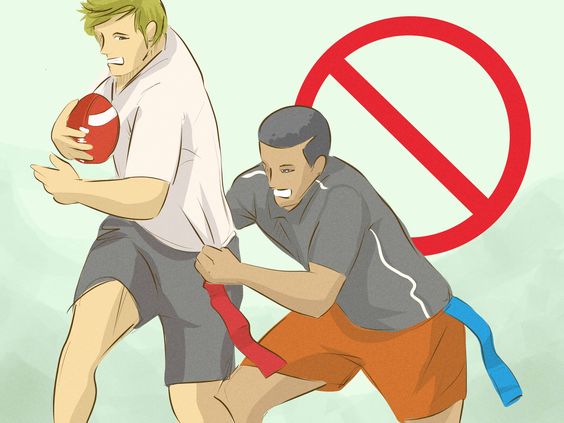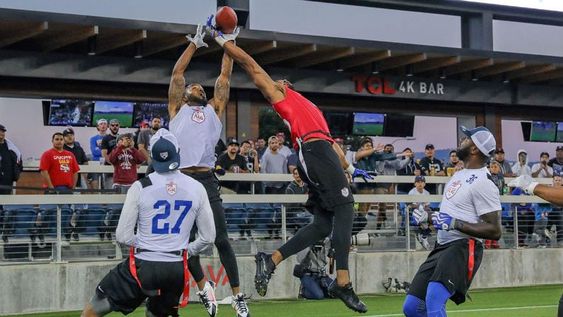What is Flag Football
Flag football is a popular variation of American football that eliminates the tackling aspect of the game, replacing it with the simple removal of a flag from the ball carrier’s belt. This modification not only makes the sport safer but also more accessible to a wider range of players, from children to adults. Unlike traditional football, which requires extensive padding and rigorous physical contact, flag football focuses on speed, strategy, and agility. It’s a thrilling sport that combines the excitement of football with the tactics of flag-pulling.
History of Flag Football
The origins of flag football can be traced back to the 1940s when it was primarily played as a recreational sport among military personnel. It gained popularity in schoolyards and community centers as a safer alternative to tackle football. Over the decades, the sport has evolved significantly, with formal rules and leagues being established to accommodate players of all ages and skill levels. Also, read about What is an Edge in Football
Rules and Gameplay
Basic Rules
In flag football, teams typically consist of 5 to 8 players per side. The objective is to score touchdowns by advancing the ball down the field and crossing into the opposing team’s end zone. Instead of tackling, defensive players aim to remove the ball carrier’s flag, which signifies a “tackle” and ends the play.
Field and Equipment
The playing field is usually smaller than a traditional football field, often about 50 yards long with end zones at both ends. Players wear belts with flags attached to each side of their hips, which serve as the primary means of “tackling.” The ball used in flag football is similar to a regular football but slightly smaller, facilitating easier gripping and throwing.
Scoring
Scoring in flag football is identical to traditional football, with touchdowns worth 6 points. Extra points can be scored by running or passing the ball into the end zone after a touchdown. Alternatively, teams can opt for a one-point conversion from a shorter distance or a two-point conversion from a further distance. Discover more information dynamichub.ca
Benefits of Playing Flag Football
Physical Fitness
Flag football promotes physical fitness by requiring players to run, pass, and evade defenders. It enhances cardiovascular endurance, agility, and hand-eye coordination without the risk of serious injury associated with tackle football.
Accessibility
Due to its non-contact nature, flag football is suitable for individuals of all ages and fitness levels. It’s commonly played in schools, recreational leagues, and even corporate team-building events, fostering camaraderie and sportsmanship among participants.
Skill Development
The sport emphasizes strategic thinking, teamwork, and quick decision-making. Players develop offensive and defensive tactics, learn to read their opponents, and improve their overall football skills in a fun and competitive environment.

Popular Flag Football Leagues and Tournaments
NFL Flag
NFL Flag is one of the largest youth flag football organizations in the United States, providing opportunities for children to play in leagues and tournaments sanctioned by the National Football League. It promotes the values of sportsmanship, teamwork, and healthy competition among young athletes.
International Flag Football
Flag football has gained international recognition, with numerous countries organizing leagues and tournaments at both recreational and competitive levels. The International Flag Football Federation (IFFF) oversees international competitions and promotes the sport’s growth globally.
Conclusion
Flag football continues to grow in popularity as a safer alternative to traditional tackle football. Its emphasis on skill, strategy, and inclusivity makes it appealing to players of all ages and abilities. Whether you’re a seasoned athlete or new to the sport, flag football offers a thrilling experience that combines athleticism with camaraderie.
FAQs
1. What equipment do you need to play flag football?
To play flag football, you typically need a football (slightly smaller than a standard football), flags and belts for each player, and a field with marked end zones. Cleats and comfortable athletic clothing are also recommended.
2. Is flag football safer than tackle football?
Yes, flag football is generally considered safer than tackle football because it eliminates the physical contact involved in tackling. Instead of tackling, defenders remove flags from the ball carrier’s belt to stop the play, reducing the risk of injuries such as concussions and fractures.
3. How many players are on a flag football team?
A flag football team usually consists of 5 to 8 players per side, depending on the specific league or tournament rules. This smaller team size allows for more participation and involvement from each player during the game.
4. What are the basic rules of flag football?
In flag football, the main objective is to score touchdowns by advancing the ball into the opposing team’s end zone. Players must avoid physical contact, and defensive players “tackle” by pulling the ball carrier’s flag. Other rules include passing and running plays, scoring points for touchdowns, and conversions after scoring.
5. Where can you play flag football?
Flag football is played in various settings, including schools, community leagues, recreational centers, and organized tournaments. Many cities and towns have local flag football leagues for both youth and adults, offering opportunities for people of all ages to participate in this exciting sport.




